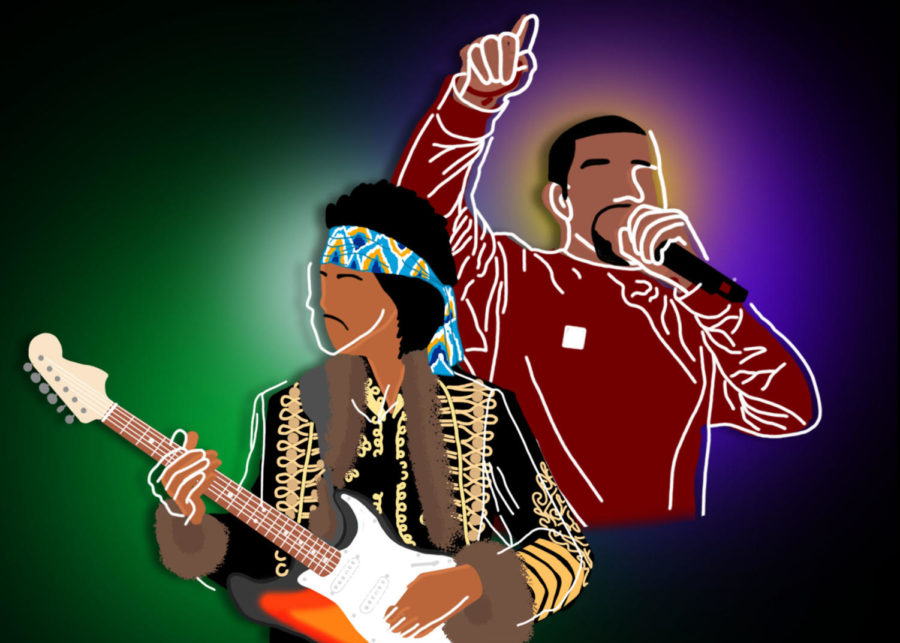Black History Month: Meaning throughout African American music
Jimi Hendrix and Kanye West are two of the many influential black artists. Coppell Student Media web producer Andrés Bear discusses the evolution of black music and its meaning throughout history.
February 28, 2019
From Stevie Wonder to Michael Jackson, countless black musicians throughout history have found themselves in the position of being cultural icons and industry giants. All the more interesting, however, is the meaning behind music they have created.
Long before Woodstock or Coachella, the story of African American music starts with the transatlantic slave trade. The triangle funneled West Africans into a treacherous journey across the Atlantic. Even though it consumed their very senses, they did not forget music.
“African rhythms were in [Africa] hundreds of years ago before they were even brought in the African diaspora with people coming into America,” Coppell High School AP World History/European History teacher Dan Gillette said. “[African Americans] remembered the rhythms, and they are going to stay with them for generations.”
A rough, albeit necessary, genre formed on America’s plantations as slaves chanted “slave songs” across the colonies and its cotton fields. Harriet Tubman was a key figure in the Abolitionist movement. She found herself, along with countless slaves, harnessing the power of such songs to convey coded information beneficial to the Underground Railroad.
According to the Harriet Tubman Historical Society, “Coded songs contained words giving directions on how to escape also known as signal songs or where to meet known as map songs.”
Slave chants, along with early African American genres such as blues, jazz, gospel, rhythm and blues and soul, each have deep roots in the traditional music of Africa. The stories, the struggle which early African Americans sang about gave them hope in the midst of racial injustice.
A hundred years after the Civil War, rock ‘n’ roll began to take form in the 1950s as a genre born out of the marriage between southern and northern sounds. Up the Mississippi river in Tennessee, Memphis musicians crafted records which reached every radio and neon-lit jukebox from the Atlantic to the Pacific ocean.
“Artists such as Big Mama Thornton, Big Joe Turner and T-Bone Walker are all black artists who made it big pre and post World War II with blues and ‘boogie woogie’,” iSchool High of Lewisville junior Jaide Walker said. “They paved the way for artists such as Janis Joplin and Elvis Presley, yet they don’t get enough credit for that.”
Black musicians such as Jimi Hendrix and Chuck Berry were electric guitar wielding pioneers who introduced many to rock with their top-charting hits. It would take a thousand pages or minutes to explain the influence of each African American rockstar – A to Z.
Rock, with the help of white and black musicians, found itself pushing sonic boundaries and creating an all-American sound. It was a movement with attitude and free-spirit. Enough so that it brought the racially segregated American youth closer than ever before.
No longer was music defined by race, but by sound.
Not by color, but by talent.
“In a lot of those original rock concerts they would let blacks and whites in, but there was a rope running down the middle to keep them separated,” Gillette said. “Halfway through the concert that rope was gone. There’s white kids dancing with black kids, and there are no fights.”
Hip-hop broke onto the scene during the late 1970s as a genre hailing from the Bronx in New York. The genre began its long journey in the block parties of Bronx as a rough and youthful rhythm driven urban sound. Similar to rock, it was a movement led by the youth and for the youth.
As the years progressed, hip-hop spread across America. By the 1990s and 2000s, hip-hop had reached worldwide charts and spawned regional subgenres. The west coast was home to gangsta rap heard through N.W.A, Wu-Tang Clan and Tupac Shakur while the east coast reveled in introspective lyricism from The Notorious B.I.G, Nas and A Tribe Called Quest.
Meanwhile, the south held it down it with Outkast, Master P and Clipse. Those are just a few heroes which kids from hundreds of streets looked up to. African American artists from the current decade grew up with hip-hop. For many, it was the catalyst for their artistic inclination.
“With rap there is not too much different than old blues,” Gillette said. “They are coming from the heart. They are saying, ‘this is my story and this is my life’.”
One of those kids grew up to be Kendrick Lamar, whose album To Pimp A Butterfly details the internal and external struggles African American communities face.
The album cover, a group of black men posted in front of the white house, is a black statement in and of itself. In the same way slave songs tackled slavery, hip-hop often finds itself tackling minority struggles in its music in order to spark conversation.
“As time progresses on, people will look back say, ‘I can see that this is a work of art’,” CHS junior Rodney McCarty said. “[Future historians] will take the time to breakdown African American music and say, ‘this [is important], this [is important], this might not have been good’ instead of just labeling everything as good.”
Since the days of the abolitionist movement, African American music has continuously carried deep, societal implications. The tendency for black art, as a whole, to break conventions is necessary to understand when breaking down African American music.
Follow Andrés @_andresbear












Laura Amador • Mar 6, 2019 at 10:40 am
Bailey! The graphic is amazing!